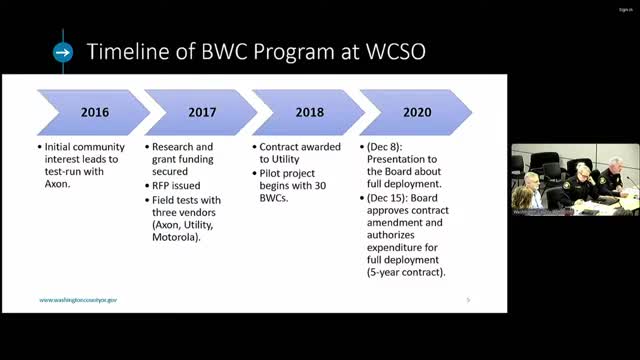Taser inventory overhaul sparks debate on effectiveness and safety
October 01, 2024 | Washington County, Oregon
This article was created by AI summarizing key points discussed. AI makes mistakes, so for full details and context, please refer to the video of the full meeting. Please report any errors so we can fix them. Report an error »

During a recent government meeting, officials discussed the current state of tasers in their inventory, revealing significant concerns about the aging equipment and its effectiveness. The department currently utilizes three models: the Taser 7, Taser X26P, and the older X26 model. The Taser 7, introduced in 2018, boasts a 75% successful deployment rate, while the X26P, dating back to 2013, has a notably lower success rate of 50%. The oldest model, the X26, has been in service since 2003 and lacks documented deployment success rates.
Officials recommended standardizing the inventory with the Taser 7, which is supported by the vendor and has a recommended lifespan of five years. This decision comes amid concerns about the aging equipment, with many units exceeding their expected operational life. The discussion highlighted the need for a structured replacement program to ensure that officers are equipped with reliable tools for their duties.
In addition to tasers, the meeting also addressed issues with body-worn cameras. Officials reported ongoing challenges with battery life, connectivity, and safety concerns related to the current utility camera system. The existing cameras often fail to last an entire shift, and there have been reports of battery swelling, raising safety alarms among staff. Comparatively, the Axon camera system was noted for its superior design and functionality, although it too has faced operational issues.
The meeting underscored the importance of investing in updated technology for both tasers and body-worn cameras to enhance officer safety and operational effectiveness. The discussions reflect a broader commitment to improving equipment standards and addressing the challenges posed by outdated technology in law enforcement.
Officials recommended standardizing the inventory with the Taser 7, which is supported by the vendor and has a recommended lifespan of five years. This decision comes amid concerns about the aging equipment, with many units exceeding their expected operational life. The discussion highlighted the need for a structured replacement program to ensure that officers are equipped with reliable tools for their duties.
In addition to tasers, the meeting also addressed issues with body-worn cameras. Officials reported ongoing challenges with battery life, connectivity, and safety concerns related to the current utility camera system. The existing cameras often fail to last an entire shift, and there have been reports of battery swelling, raising safety alarms among staff. Comparatively, the Axon camera system was noted for its superior design and functionality, although it too has faced operational issues.
The meeting underscored the importance of investing in updated technology for both tasers and body-worn cameras to enhance officer safety and operational effectiveness. The discussions reflect a broader commitment to improving equipment standards and addressing the challenges posed by outdated technology in law enforcement.
View full meeting
This article is based on a recent meeting—watch the full video and explore the complete transcript for deeper insights into the discussion.
View full meeting
